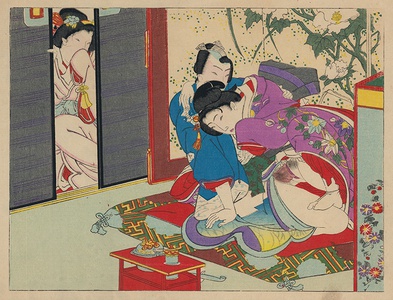| Method | Woodblock (nishiki-e) |
| Artist | Attributed to Toyohara Chikanobu (1838-1912) |
| Published | c. 1890 |
| Dimensions | Chuban [~190 x 255 mm] |
| Notes |
A Meiji Era shunga in the style of Chikanobu featuring two seated lovers in mid coitus. The woman crouches over her lover wearing a kimono with kikyo (campanula bell flower) motif, a symbol of honesty, obedience, and unchangeable love. The background features a folding screen with a white anemone on it, beyond which another woman watches through the sliding doors holding her left kimono sleeve to her mouth. The Meiji Era marked the end of the Shogunate, the restoration of the Imperial Family, and the full opening of Japan to the West. As Japan opened up, the Meiji administration sought to bring Japanese societal practices in line with Western standards of morality. These factors had several effects on Meiji shunga output. As Japanese society became more open tastes changed at the same time that artists began to be schooled in Western styles. Printmakers of ukiyo-e no longer produced any prints, but other forms of shunga were still being made through the end of the nineteenth century and into the twentieth. This material was still being produced using deluxe printing methods, but it was stylistically simpler and more often produced as suites of prints and painting rather than in book format. Shunga is the term used for the body of erotic imagery produced in Japan from 1600 to 1900. The term shunga means spring pictures, a euphemism for sex, and is one of several names for erotic material produced in Japan. Shunga took different formats: painted hand scrolls, painted books, printed books and albums, and sets of prints which were sometimes sold in wrappers. As prints they are one of the genres of ukiyo-e, or Floating World prints, which also include fukeiga (landscape prints), and bijin-ga (prints of beautiful women). Most of the major ukiyo-e artists produced shunga material at some point during their careers, including Utamaro (who produced more erotic books than non-erotic books), Hokusai, and Hiroshige. Produced at the same time as the introduction of full colour woodblock printing, shunga prints and books were made using the most lavish and complicated printing techniques, including gauffrage, metallic inks, mica, complicated printed patterns, and multicolour printing using a high number of different colours. Although prolific in its number and variety, shunga should be seen as more representative of the ideals of the ukiyo, with its emphasis on mutual pleasure, rather than as an accurate representation of Japanese attitudes and practices of sexuality. Shunga present an invitation to pleasure through the bliss of lovemaking and though largely heteronormative, they portray the full gamut of couplings, married or otherwise, often surrounded by lavish settings and objects of pleasure. Toyohara Chikanobu (1838-1912) was a student of Toyohara Kunichika (not to be confused with the Kunichika Toyohara (1835-1900) of the same name). Originally Hashimoto, he took both the last name and the second part "chika" of his master's first name. This followed an old tradition of students inheriting the already established names of their masters. Favourite subjects of Chikanobu were historical and mythological legends and histories from Japan's past and genre scenes with women and children. The percentage of triptychs among the prints created by the artist is maybe higher than for any other artist of the Meiji period. His best known series are triptychs showing court life in and around the Chiyoda Palace. Like Chikanobu's contemporary, Yoshitoshi, his print themes concentrate on the history and traditional values of old Japan. These series must be seen against the background of an era when Japan was striving to adopt Western technology and culture. Shunga is the term used for the body of erotic imagery produced in Japan from 1600 to 1900. The term shunga means spring pictures, a euphemism for sex, and is one of several names for erotic material produced in Japan. Condition: Minor dirt staining to bottom right edge of sheet. |
| Framing | framed |
| Price | £300.00 |
| Stock ID | 53272 |

